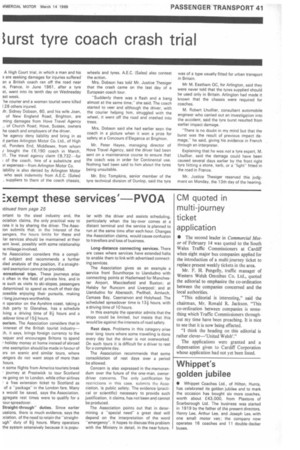Exempt these services' PVOA
Page 43

If you've noticed an error in this article please click here to report it so we can fix it.
rtinued from page 25
ortant to the steel industry and, the °dation claims, the only practical way to rate it is by sharing the driver. The Assoion submits that, in the interest of the sengers, the hours limits for these and lar services should be maintained at their ;ant level, possibly with some relationship le mileage involved.
he Association considers this a compli{I subject and recommends a further ilied analysis of the position, if a straighttard exemption cannot be provided.
ecreational trips. These journeys arise A often in the field of private hire, and in is such as visits to ski-slopes, passengers determined to spend as much of their day Dossible enjoying their pursuits, making r long journeys worthwhile.
n operator on the Ayrshire coast, taking a :lib party to Glenshee, has a schedule lying a driving time of 81 hours and a adover time of 15ihours.
ourism. The Association considers that in interest of the British tourist industry— h, it says, brings foreign currency to the lequer and encourages Britons to spend holiday money at home instead of abroad )me exemption should be made in favour of ars on scenic and similar tours, where ;engers do not want stops of more than hours.
n some flights from America tourists break journey at Prestwick to tour Scotland re going on to London, while other airlines • a free extension ticket to Scotland as of a "package" in the London fare. Many s would be saved, says the Association, jgregate rest times were to qualify for a lour spreadover.
Straight-through" duties. Since earlier ussions, there is much evidence, says the )ciation, of the need to retain the "straightugh" duty of 8+ hours. Many operators the system extensively because it is popu lar with the driver and assists scheduling, particularly when the lay-over comes at a distant terminal and the service is planned to run at the same time after each hour. Changes the Association claims, would cause confusion to travellers and loss of business.
Long-distance connecting services. There are cases where services have extended halts to enable them to link with advertised connecting services.
The Association gives as an example a service from Scunthorpe to Llandudno with connecting points at Hazlemead for Manchester Airport, Macclesfield and Buxton: at Helsby for Runcorn and Liverpool: and at Llandudno for Abersoch, Pwllheli, Amlwch, Cemaes Bay, Caernarvon and .Holyhead. The scheduled spreadover time is 131 hours, with a driving time of 10 hours.
In this example the operator admits that the stops could be limited, but insists that this would be against the interests of road safety.
Rest days. Problems in this category arise over long tours where some travelling is done every day but the driver is not overworked. On such tours it is difficult for a driver to rest for a complete day.
The Association recommends that some consolidation of rest days over a period be allowed.
Concern is also expressed in the memorandum over the future of the one-man, ownerdriver concerns. The only justification for restrictions in this case, submits the Association, is public safety. The evidence (practical or scientific) necessary to provide such justification, it claims, has not been and cannot be produced.
The Association points out that in determining a "special need" a great deal will depend on the interpretation of the word "emergency-. It hopes to discuss this problem with the Ministry in detail, in the near future.




















































































































